Question 1 - Order of Implicit & Explicit methods
Contents
Exact solution
function q1_solution
We solve the logistic equation
![$$
\begin{array}{rcll}
x'(t) &=& (a-bx(t))x(t), &\qquad t\in[0,2], \\
x(0) &=& x_0,
\end{array}
$$](q1_solution_eq05500588395696120218.png)
with  ,
,  , which has the known exact solution
, which has the known exact solution

x0 = 2; timepoint = 2; exact = x0*exp(timepoint)/(1-x0*(1-exp(timepoint))); no_approx = 10; h = 0.5.^(1:no_approx)';
Euler
error = zeros(no_approx,1); for ei=1:no_approx x = solve(@eul, @logistic, 0, 2, x0, h(ei), timepoint); error(ei) = norm(exact-x); end [p,q]=regrese(h,error); figure; plot(h,error,'-ro'); title('Euler'); xlabel('\tau'); ylabel('error'); figure; loglog(h,error,'-ro'); title('Euler') xlabel('\tau'); ylabel('error'); fprintf('Euler = %f + %f x log10(tau)\n', q, p);
Euler = -0.872400 + 1.011654 x log10(tau)


We can see that for Euler  .
.
Runge
error = zeros(no_approx,1); for ei=1:no_approx x = solve(@runge, @logistic, 0, 2, x0, h(ei), timepoint); error(ei) = norm(exact-x); end [p,q]=regrese(h,error); figure; plot(h,error,'-ro'); title('Runge'); xlabel('\tau'); ylabel('error'); figure; loglog(h,error,'-ro'); title('Runge') xlabel('\tau'); ylabel('error'); fprintf('Runge = %f + %f x log10(tau)\n', q, p);
Runge = -0.806076 + 2.124211 x log10(tau)

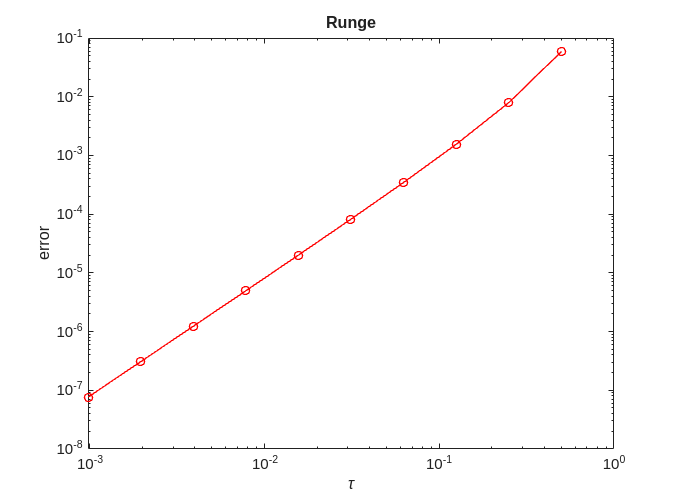
We can see that for Runge  .
.
Runge-Kutta
error = zeros(no_approx,1); for ei=1:no_approx x = solve(@rk_classical, @logistic, 0, 2, x0, h(ei), timepoint); error(ei) = norm(exact-x); end [p,q]=regrese(h,error); figure; plot(h,error,'-ro'); title('Runge-Kutta'); xlabel('\tau'); ylabel('error'); figure; loglog(h,error,'-ro'); title('Runge-Kutta') xlabel('\tau'); ylabel('error'); fprintf('Runge-Kutta = %f + %f x log10(tau)\n', q, p);
Runge-Kutta = -2.228915 + 3.970831 x log10(tau)
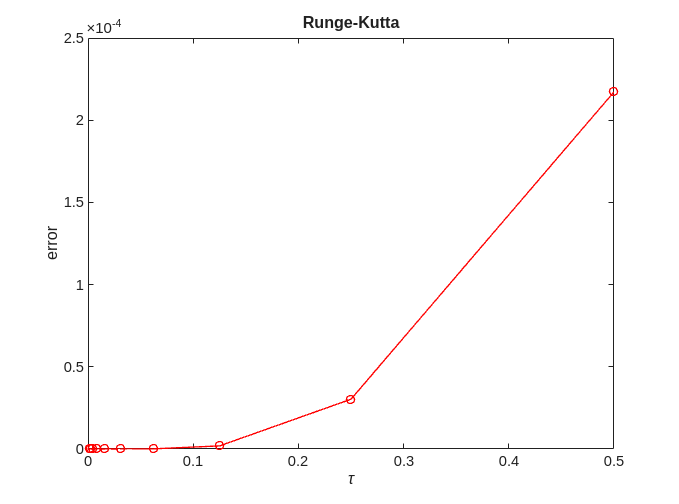
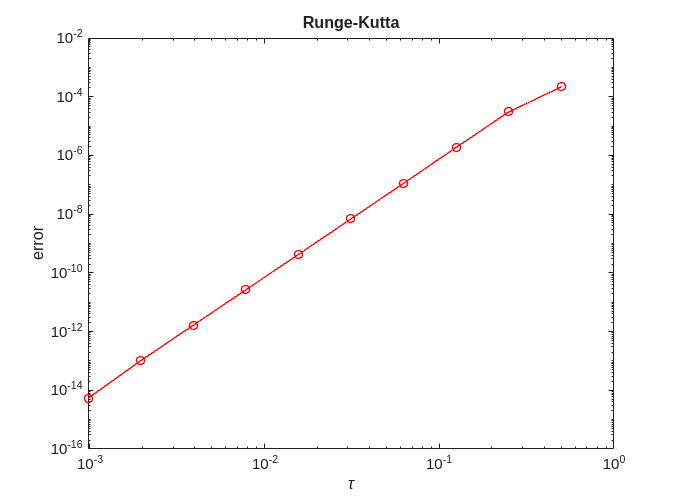
We can see that for Runge-Kutta  .
.
Heun
error = zeros(no_approx,1); for ei=1:no_approx x = solve(@heun, @logistic, 0, 2, x0, h(ei), timepoint); error(ei) = norm(exact-x); end [p,q]=regrese(h,error); figure; plot(h,error,'-ro'); title('Heun'); xlabel('\tau'); ylabel('error'); figure; loglog(h,error,'-ro'); title('Heun') xlabel('\tau'); ylabel('error'); fprintf('Heun = %f + %f x log10(tau)\n', q, p);
Heun = -1.068869 + 2.057883 x log10(tau)
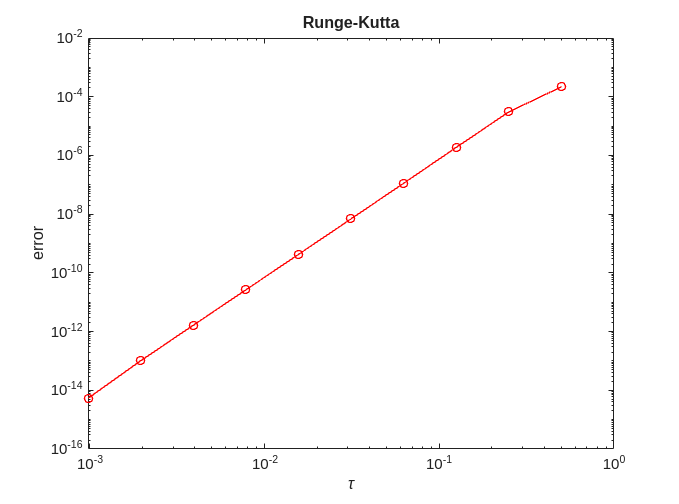
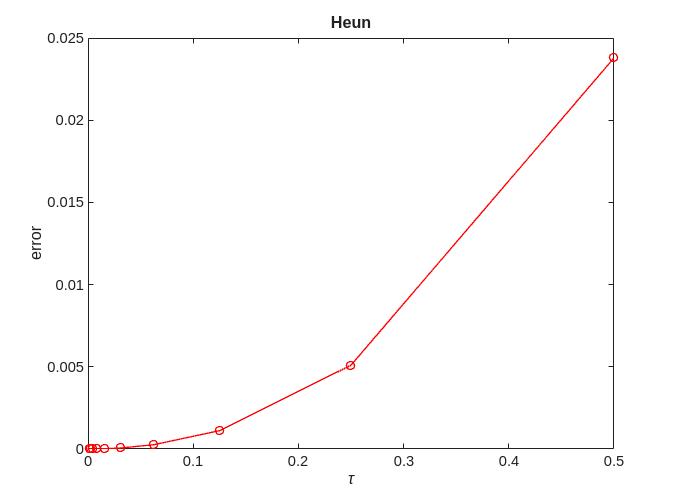
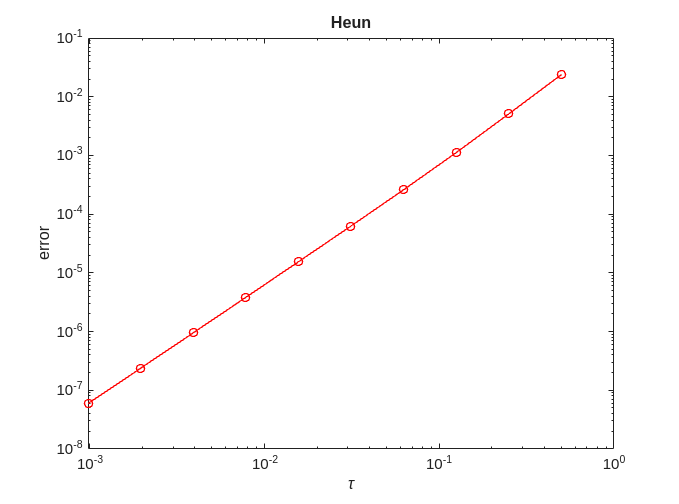
We can see that for Heun  .
.
Implicit Euler
Note, we start from h=1/4, as Implicit Euler fails to converge for h=1/2
for tol=[0.1,0.001,0.0001,0.00001] error = zeros(no_approx,1); h = 0.5.^(1+(1:no_approx))'; % start from 1/4 (.5^2) for ei=1:no_approx x = solve(@ieuler, @logistic, 0, 2, x0, h(ei), timepoint, tol); error(ei) = norm(exact-x); end [p,q]=regrese(h,error); figure; plot(h,error,'-ro'); title(['Implicit Euler (tol=' num2str(tol) ')']); xlabel('\tau'); ylabel('error'); figure; loglog(h,error,'-ro'); title(['Implicit Euler (tol=' num2str(tol) ')']); xlabel('\tau'); ylabel('error'); fprintf('Implicit Euler (tol=%f) = %f + %f x log10(tau)\n', tol, q, p); end
Implicit Euler (tol=0.100000) = -0.818021 + 1.027462 x log10(tau) Implicit Euler (tol=0.001000) = -0.902095 + 0.998404 x log10(tau) Implicit Euler (tol=0.000100) = -0.901978 + 0.998643 x log10(tau) Implicit Euler (tol=0.000010) = -0.901963 + 0.998655 x log10(tau)



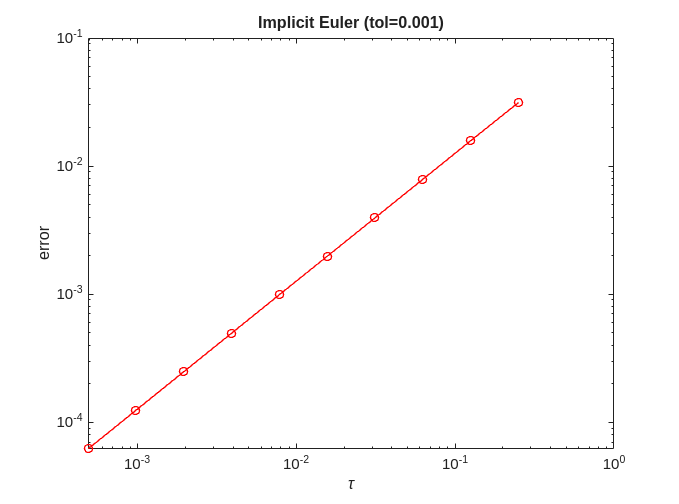

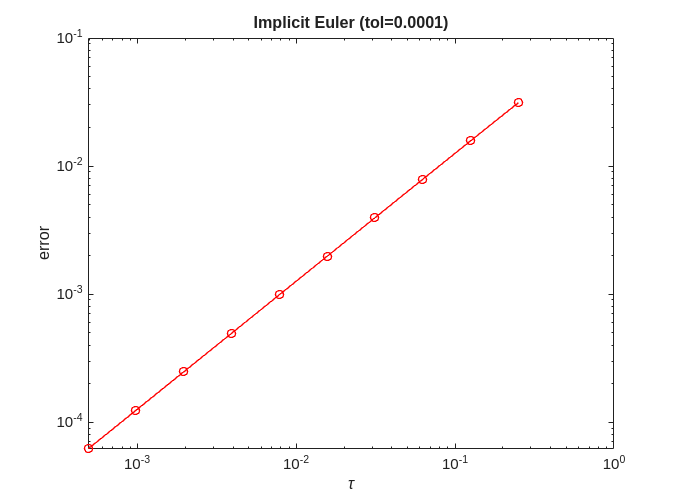


We can see that for Implicit Euler  .
.
Crank-Nicholson
for tol=[0.1,0.001,0.0001,0.00001] error = zeros(no_approx,1); for ei=1:no_approx x = solve(@crank_nicholson, @logistic, 0, 2, x0, h(ei), timepoint, tol); error(ei) = norm(exact-x); end [p,q]=regrese(h,error); figure; plot(h,error,'-ro'); title(['Crank-Nicholson (tol=' num2str(tol) ')']); xlabel('\tau'); ylabel('error'); figure; loglog(h,error,'-ro'); title(['Crank-Nicholson (tol=' num2str(tol) ')']); xlabel('\tau'); ylabel('error'); fprintf('Crank-Nicholson (tol=%f) = %f + %f x log10(tau)\n', tol, q, p); end
Crank-Nicholson (tol=0.100000) = -1.985822 + 1.712550 x log10(tau) Crank-Nicholson (tol=0.001000) = -0.985795 + 2.277137 x log10(tau) Crank-Nicholson (tol=0.000100) = -1.254186 + 2.037598 x log10(tau) Crank-Nicholson (tol=0.000010) = -1.305834 + 2.001045 x log10(tau)

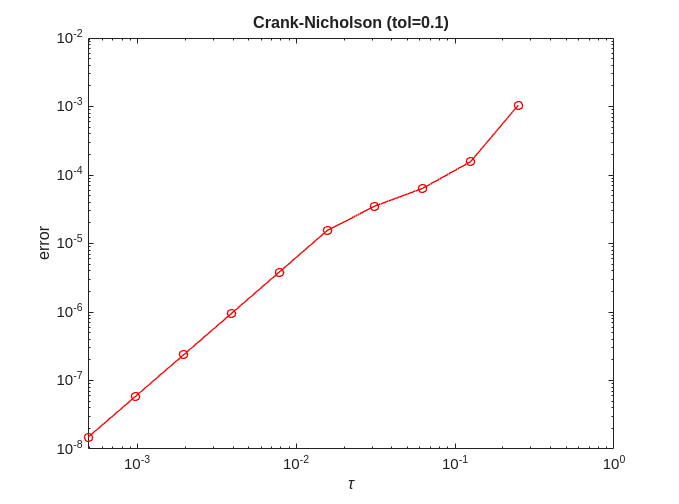
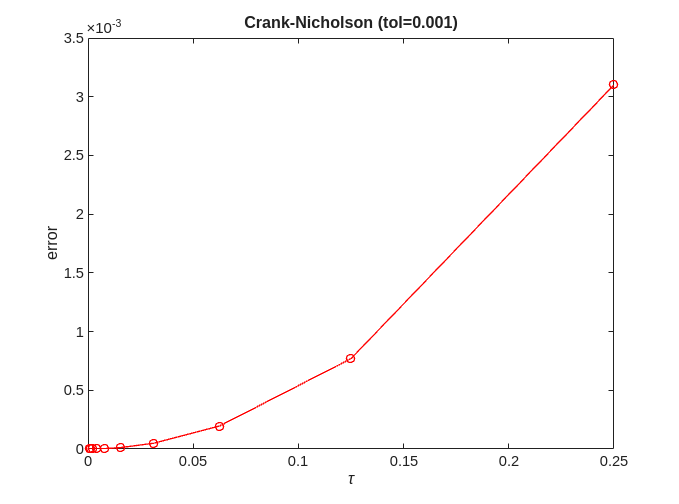

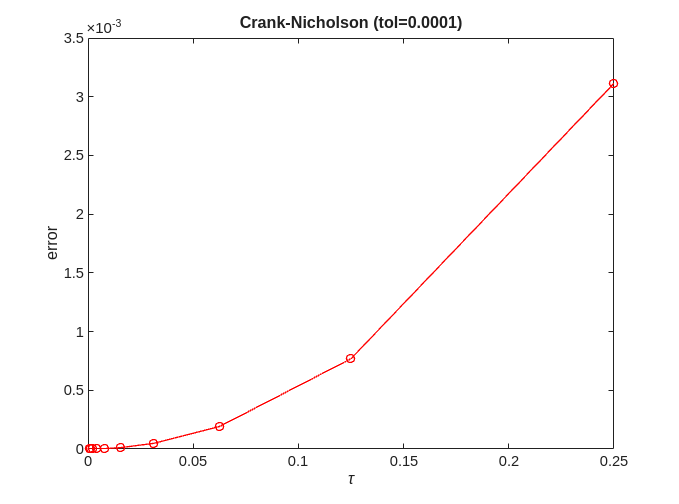

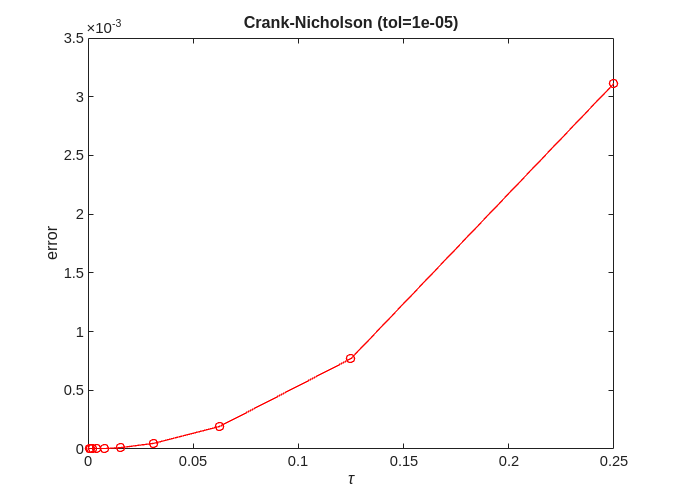

We can see that for Crank-Nicholson  providing tol is sufficiently small
providing tol is sufficiently small
Solve function
Function to run the specified solver and extract the value at the specified timepoint
function y = solve(solver, field, t0, T, x0, h, timepoint, varargin) %SOLVE Use the specified ODE solver to solve the ODE and get value at % specified time point % % Parameters: % solver -- ODE solve to use % field -- Right hand side function of ODE system: x'=f(t,x) % t0 -- Initial time % T -- End time (T > t0) % x0 -- Initial value % h -- Size of time step (h <= T-t0) % timepoint -- Timepoint to get numerical solution at % varargin -- Extra arguments to pass to the solver % % Returns: Computed value at timepoint [t,x] = feval(solver, field, t0, T, x0, h, varargin{:}); n1 = floor((timepoint-t0)/h); n2 = ceil((timepoint-t0)/h); if n1 == n2 y = x(n1+1,:); else y1 = x(n1+1,:); y2 = x(n2+1,:); t1 = t(n1+1); t2 = t(n2+1); y = y1 + (y2-y1)*(timepoint-t1)/(t2-t1); end end
Linear Regression
Function to perform linear regression in log-log coordinates
function [p,q]=regrese(x,y) % REGRESE Compute linear regression % % Fits the line log10(y) = p log10(x) + q in "loglog" coordinates % % Returns: p, q % p = estimated order of the method data=[log10(x),log10(y)]; m=length(x); A=[data(:,1), ones(m,1)]; coeffs=A\data(:,2); p=coeffs(1); q=coeffs(2); end
end